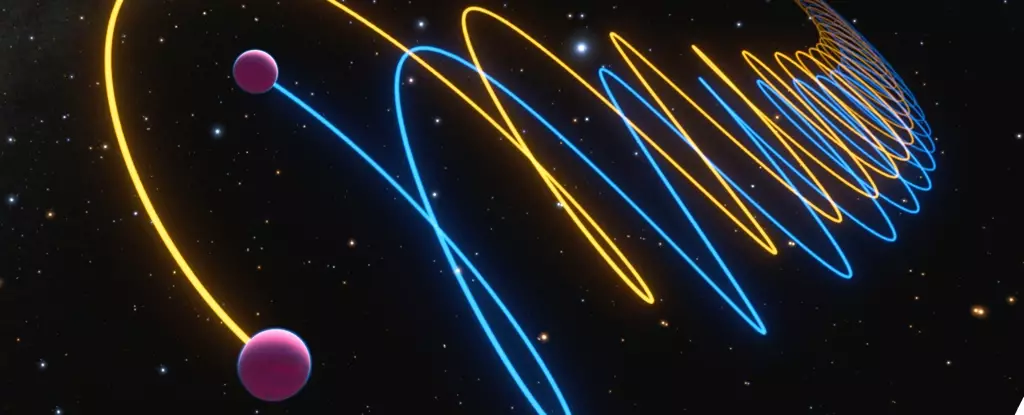In the emotional fabric of astrophysics, few discoveries resonate as profoundly as the identification of Gliese 229 B, a brown dwarf observed in 1995 by researchers at Caltech’s Palomar Observatory. Situated approximately 19 light-years from our home planet, Gliese 229 is a red dwarf star the size of which is akin to those that populate the Universe. However, the unexpected dimness of Gliese 229 B, which boasts approximately 70 times the mass of Jupiter, sparked curiosity and intrigue among scientists. The question that loomed for decades was: Why was this brown dwarf so faint? Recent groundbreaking research has unveiled that Gliese 229 B is not a solitary object but rather a twin system of brown dwarfs, transforming our understanding of these intriguing celestial bodies.
The original discovery of Gliese 229 B signaled a monumental leap in substellar astronomy, marking the first confirmed observation of a brown dwarf—a category of celestial objects that serve as the elusive connectives between gas giants and actual stars. Initial observations, revealing methane in the atmosphere of Gliese 229 B, hinted at its complex nature. This revelation was pivotal, as it only strengthened the idea that astronomers had unearthed a category of objects previously predicted but not yet observed well. An exciting sentiment echoed among scientists, especially amidst the Caltech team, who faced the joy and challenge of demystifying a new frontier of knowledge.
The recent study led by graduate student Jerry W. Xuan, along with respected professor Dimitri Mawet and an international team from numerous esteemed institutions, elucidates the structure of Gliese 229 B. Published in the prestigious journal Nature, it reveals that Gliese 229 B actually comprises twin brown dwarfs—Gliese 229 Ba and Gliese 229 Bb—each boasting masses around 34 to 38 times that of Jupiter. The confirmation of this dual nature adds a vital piece to the puzzle of understanding brown dwarfs, a significant class of astronomical entities that straddle the binary classifications of stars and planets.
Resolving the nature of Gliese 229 B demanded advanced observational techniques that underscored the ingenuity of modern astronomy. Researchers employed the GRAVITY interferometer, an exceptional instrument located at the European Southern Observatory’s Very Large Telescope in Chile. This tool enabled scientists to distinguish the two closely orbiting brown dwarfs, shedding light on their elusive characteristics. Furthermore, with the aid of the CRyogenic high-resolution InfraRed Echelle Spectrograph (CRIRES+), the research team discerned distinct spectral signatures emanating from the binary system and measured their Doppler shifts. These sophisticated methodologies ultimately provided incontrovertible evidence, correlating their observed brightness levels to theoretical expectations of two brown dwarfs of this mass.
The implications of this discovery extend far beyond simply rectifying the luminosity and mass relationship of Gliese 229 B. It challenges existing knowledge surrounding the formation mechanisms of brown dwarfs. With hypotheses suggesting that such binaries may result from the fragmentation of a protoplanetary disk, the discovery of Gliese 229 B inspires further exploration into brown dwarfs’ formation processes. This significantly alters our understanding of stellar evolution, suggesting that brown dwarfs may frequently exist in pairs, much like stars and planets.
As researchers analyze their discoveries, the question now arises: How many other binary brown dwarf systems are silently orbiting distant stars, waiting to be uncovered? The suggestions made by the study not only open avenues for questions but intrigue scientists about the potential existence of similar pairings lurking in distant reaches of the cosmos.
The journey of understanding Gliese 229 B has only just begun, with upcoming research endeavors poised to broaden the scope of investigation into brown dwarfs. Plans are underway to utilize next-generation instruments such as the Keck Planet Imager and Characterizer (KPIC) and the High-resolution Infrared SPectrograph for Exoplanet Characterization (HISPEC), both designed to delve deeper into the fascinating world of brown dwarfs and their binary potential.
Gliese 229 B—a celestial enigma at first appearing dim—has now revealed itself to be a dynamic pair of orbiting brown dwarfs. Through collaborative research and innovative technology, scientists have illuminated a critical frontier in our quest to understand the Universe’s complexity and the grand narrative of celestial bodies. As we bask in the excitement of this revelation, the adventure continues—astronomers are set to chart new territories of knowledge in substellar astrophysics.


Leave a Reply